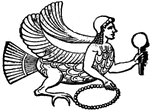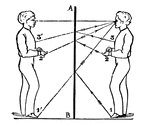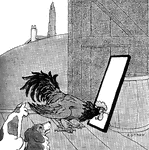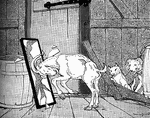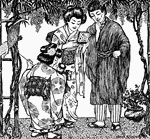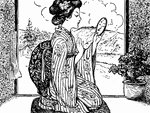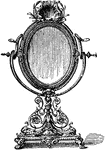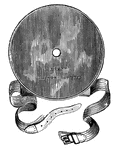
Laryngoscope
This part of the Laryngoscope consists of a large concave mirror with a small hold in the middle.

Queen looking in a mirror
The Queen of brobdignag quickly becomes fond of Gulliver. She holds him in her hand showing him around…

Jersey Cattle
"The Jersey cattle has a small deer-like head, muzzle fine and dark and encircled by a light color,…

Dining-Hall
"The dining-hall, or room with seven doors. In the December number of the New York Mirror for 1834,…
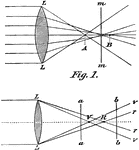
Aberration
"In optics, a deviation in the rays of light when unequally refracted by a lens or reflected…

Anamorphoscope
"An optical toy consisting of a vertical cylindrical mirror which gives a correct image of a distorted…
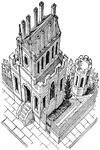
Anamorphosis
"A method of drawing which gives a distorted image of the object represented when it is viewed from…

Speculum
"Speculum, a mirror, a looking-glass. The looking-glasses of the ancients were usually made of metal,…
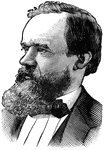
Robert Bonner
Reporter, known for working on the Courant, Republican, Mirror, and Merchant's Ledger.
Reflecting Telescope
"The reflecting telescope has an objective a concave mirror, tecnically called a speculum. The images…
Lattice Design
Also known as trellis, diaper, and network. These names are applied to any design which is repeated…
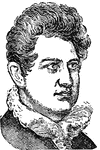
John Howard Payne
Actor and dramatist, born in New York City, June 9, 1792; died in Tunis, April 10, 1852. He was employed…
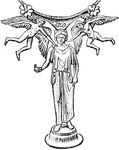
Statuette
"Bronze statuette (stand of mirror) wearing Chiton. From Athens." — Encyclopedia Britannica, 1893
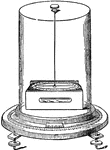
Astatic Multiplier
"The coil is of flat, rectangular shape, with a narrow central opening just large enough to allow one…
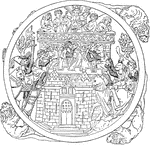
Ivory Carving
"Mirror case illustrating storming of the Castle of Love, French, about 14th century, South Kensington…
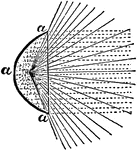
Paraboloid
"It will be seen that the parabolic mirror a is at best but a very imperfect instrument, for even if…
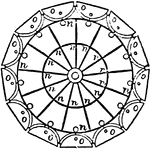
Revolving Light
"In order to produce, on the catoptric system, a fixed light showing all round the circle, a number…

Revolving Light
"If again the light was to revolve, then a revolving chandelier was employed having a certain number…

Parabolic Profile
"In order strictly to equalize a fixed light over the whole horizon, which could not possibly be done…

Catadiopteric Light
"Catadioptric Fixed Light.—This apparatus, in which a central burner is used, consists of a dioptric…
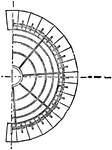
Catadiopteric Light
"Catadioptric Fixed Light.—This apparatus, in which a central burner is used, consists of a dioptric…

Catadioptric Holophote
"Catadioptric Holophote.—Part of the anterior hemisphere of rays is intercepted and at once parallelized…
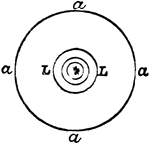
Catadioptric Holophote
"Catadioptric Holophote.—Part of the anterior hemisphere of rays is intercepted and at once parallelized…
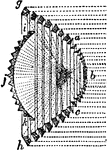
Dioptric Holophote
"Perfect Form of Dioptric Holophote for an Oil Flame.—By combining the back prisms ga, hc just described…
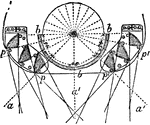
Condensing Quadrant
"Condensing Quadrant.—The fixed apparatus bbb, with spherical mirror behind, throws its rays directly…
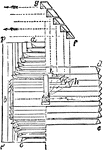
Condensing Octant
"Condensing Octant.—The central fixed apparatus bb with spherical mirror dd throws its rays directly…
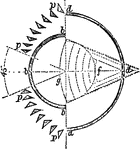
Condensing Octant
"Condensing Octant.—The central fixed apparatus bb with spherical mirror dd throws its rays directly…
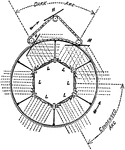
Repeating Light
"Plane mirrors M revolve on an endless chain placed outside of the apparatus and alter the direction…
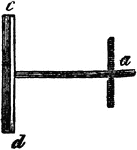
Reflection of Light
"Thus, if a sunbeam, passing through a small aperure in the window shutter a, be permitted to fall upon…
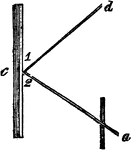
Reflecion of Light
"Let a ray pass towards a mirror in the line a, c, it will be reflected off in the direction of c, d,…

Reflection of Light
"The ray a, c, is the ray of incidence, and that from c, to d, is the ray or reflection. The angles…
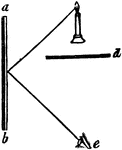
Plane Mirror
"Suppose the mirror, a b, to be placed on the side of a room, and a lamp to be set in antoher room,…
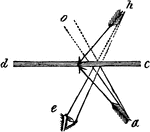
Plane Mirror
"Suppose the arrow a to be the object reflected b the mirror d c; the incident rays a, flowing from…
!["This will be understood [here] where the ray of light A B, proceeding from the eye, falls perpendicularly on the plane mirror B D. will be reflected back in the same line; but the ray C D coming from the feet, which falls obliquely on the mirror, will be reflected back under the same angle in the line D A; and since we see objects in the direction of the reflected rays, and the image appears at the same distance behind the mirror that is object is before it, we must continue the line A D to the feet, E, and for the same reason, the rays A B, from the eye, must be prolonged to F, as far behind the mirror as the line E extends, where the whole image will be represented." -Comstock 1850](https://etc.usf.edu/clipart/35800/35843/mirror3_35843_mth.gif)
Mirror Half the Length of the Object
"This will be understood [here] where the ray of light A B, proceeding from the eye, falls perpendicularly…
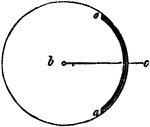
Convex Mirror
"A convex mirror is a part of a sphere, or globe, reflecting from the outside." -Comstock 1850
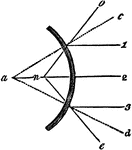
Divergent Rays
"From the surface of a plane mirror, parallel rays are reflected parallel; but the convex mirror causes…

Curved Image
"If the object a be placed obliquely before the convex mirror, then the converging rays from its two…
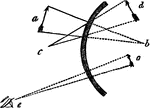
Object Diminished in Convex Mirror
"Hence the image of the object, when reflected from the convex mirror, appears smaller than the object…
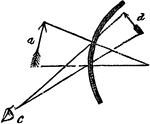
Convex Mirror
"To explain this, let us suppose that the arrow a, is diminished by reflection from the convex surface,…
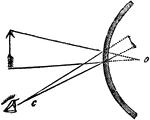
Convex Mirror
"...as the arrow is moved backwards, the angle at c, must be diminished, because the rays flowing from…
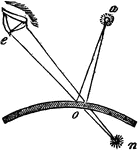
Convex Mirror
"Let us suppose that a, is a luminous point, from which a pencil of diverging rays falls upon a convex…
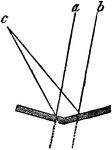
Plane Inclined Mirrors
"The incident rays, a and b, being parallel before they reach the reflectors, are thrown off at unequal…
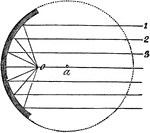
Focus of a Concave Mirror
"The focus of a concave mirror is the point where the rays are brought together by reflection." -Comstock…
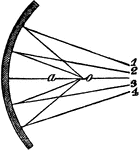
Divergent Rays in a Concave Mirror
"...be made obvious...where the diverging rays 1, 2, 3, 4 form a focus at the point o, whereas, had…
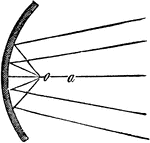
Convergent Rays in a Concave Mirror
"Thus, were the rays falling on the mirror parallel, the focus would be at a' but in consequence of…
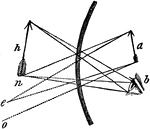
Object Within the Focus in a Concave Mirror
"...let us suppose the object a, to be placed before the mirror, and nearer to it than the principal…
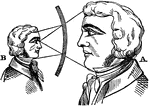
Magnified Face in a Concave Mirror
"When the concave mirror is large, say six inches in diameter, and eight or ten inches focal distance,…

Object Beyond the Focus in a Concave Mirror
"...if the object is placed more remote from the mirror than the principal focus, and between the focus…

Deception by Mirrors
"Suppose the tumbler, a, to be filled with water, and placed beyond the principal focus of the concave…
